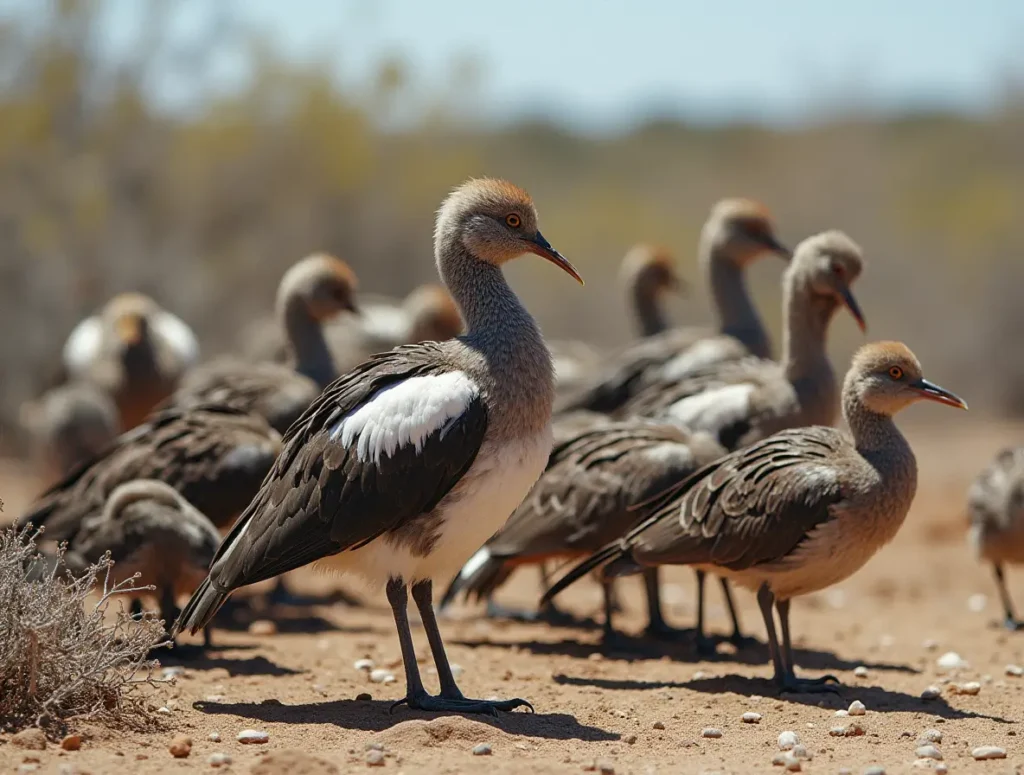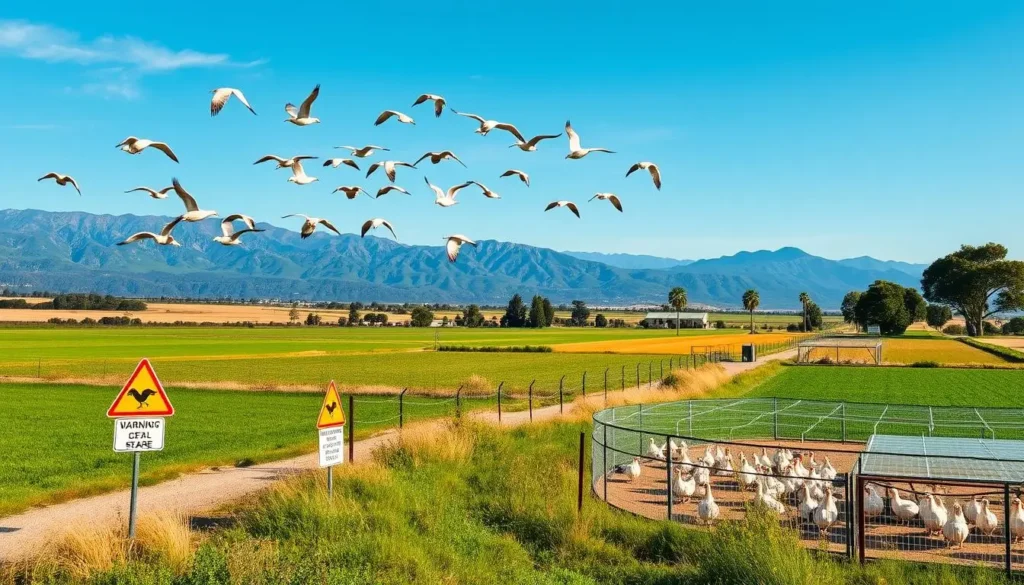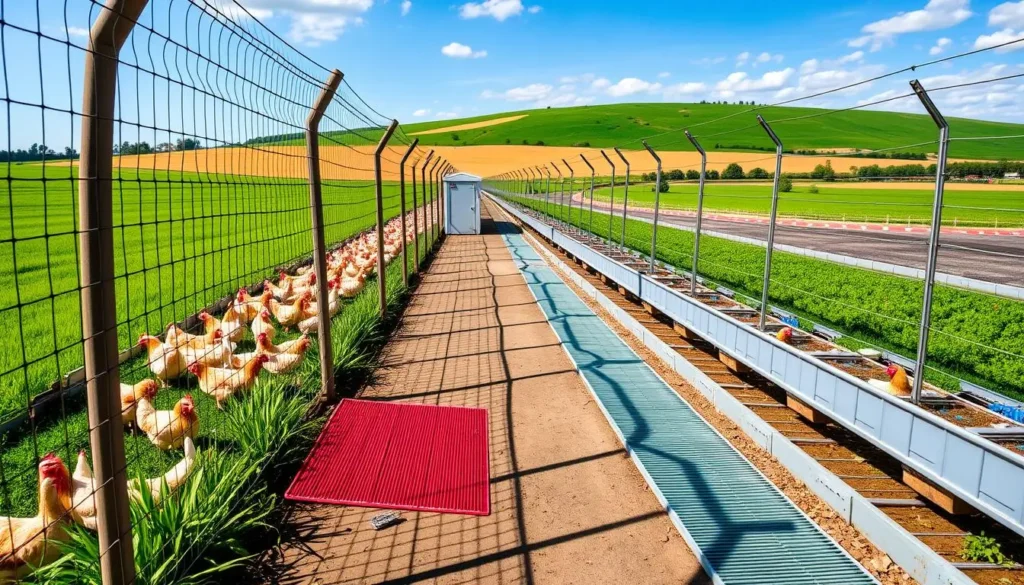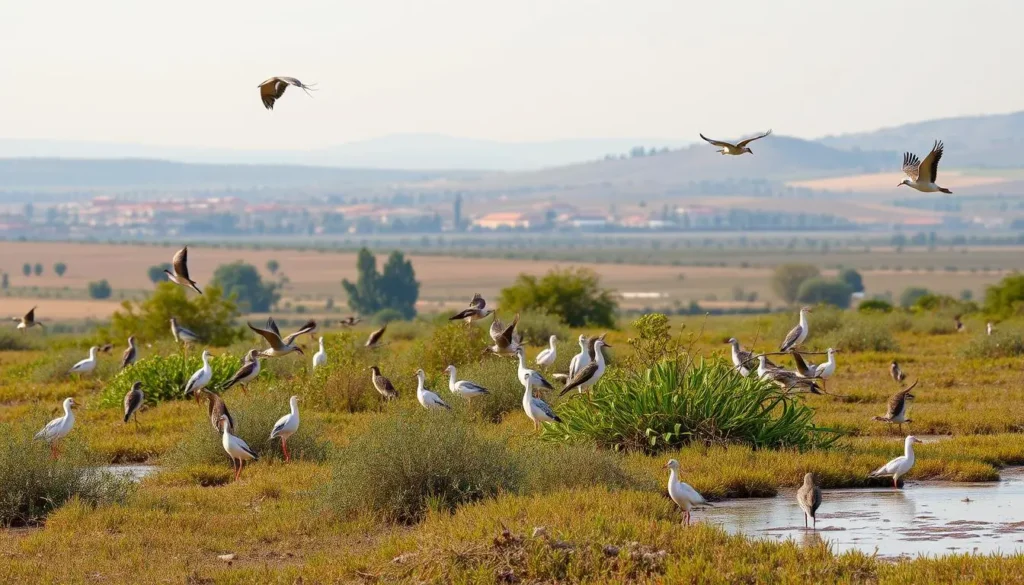California is facing a bird flu outbreak, and it’s important to know how it affects us. This guide will cover the current situation, its impact on wildlife, the poultry industry, and public health. We’ll look at how the disease is spreading and what’s being done to stop it.
Whether you’re a farmer, a concerned citizen, or just curious, this article has you covered. It will help you understand the bird flu crisis in California. You’ll learn about the latest statistics, emergency plans, and how to stay safe.

Table of Contents
Current State of Bird Flu in California
California is facing a serious bird flu outbreak, also known as avian influenza. The situation in the state shows the latest numbers, affected areas, and emergency actions. These steps aim to tackle this critical issue.
Latest Outbreak Statistics
The California Department of Food and Agriculture reports over 45 million birds hit by the bird flu as of [DATE]. This includes both big farms and small backyard flocks. The state’s $5.5 billion poultry industry is greatly affected.
Affected Regions and Counties
The bird flu has spread to many counties in California, especially in the Central Valley. Some of the most hit counties are:
- Stanislaus County
- Merced County
- Fresno County
- Kings County
- Tulare County
Emergency Response Measures
The California government has taken several emergency steps to fight the bird flu. These actions include:
- Mandatory reporting of any suspected bird flu cases
- Strict biosecurity rules for poultry farms and places
- Setting up quarantine zones around hit areas
- Culling infected flocks to stop more spread
- Watching and monitoring wild bird groups more closely
| Key Metric | Current Status |
| Total Birds Affected | Over 45 million |
| Affected Counties | Stanislaus, Merced, Fresno, Kings, Tulare |
| Poultry Industry Impact | $5.5 billion industry affected |
“The bird flu outbreak in California poses a significant threat to the state’s poultry industry and food supply. We are taking all necessary steps to contain the spread and protect the health and safety of our communities.”
– Governor [NAME], State of California
How Bird Flu Spreads and Affects Local Wildlife
Bird flu, or avian influenza, is spreading fast in California. It’s a big worry for both people’s health and wildlife. This disease can hit domestic birds and many wild bird types, upsetting the balance of nature.
Bird flu spreads through touching infected birds or their stuff, and even touching places they’ve been. Birds that travel long distances can bring the virus to new places. California’s many bird habitats and flyways make it a hotspot for this problem.
Bird flu can really hurt local wildlife. Birds that are already in trouble face a big risk of getting sick and dying. Losing these birds can mess up the food chain and hurt the whole ecosystem. Wildlife centers and conservation groups are working hard to deal with the crisis.
| Bird Species | Susceptibility to Bird Flu | Potential Impact |
| Waterfowl (ducks, geese, swans) | High | Rapid transmission, high mortality rates |
| Raptors (hawks, eagles, falcons) | Moderate | Disruption to food chain, cascading ecological effects |
| Songbirds (sparrows, finches, warblers) | Low | Potential for spillover to other species, disruption to ecosystems |
To stop bird flu and help wildlife, we need to work together. Agencies, groups, and the public must join forces. We need to watch closely, act fast, and protect California’s nature.
Economic Impact on California’s Poultry Industry
The bird flu outbreak in California has hit the poultry industry hard. Farmers and producers have lost a lot of money. They also face market problems and job losses that affect the whole agricultural sector.
Financial Losses and Market Disruption
Millions of chickens and other poultry have been killed due to bird flu. This has cost producers a lot of money. Experts think the total loss could be hundreds of millions of dollars.
The disease has also messed up supply chains and changed what people want to buy.
Employment Effects in Agricultural Sector
The bird flu crisis has hurt jobs in California’s agriculture. Poultry farms and plants have had to cut staff. It’s estimated that hundreds of jobs have been lost.
This has affected rural areas that depend on the poultry trade. The job losses have a big impact on these communities.
Recovery Projections for 2024
Experts are hopeful about the poultry industry’s recovery in 2024. If there are no more big outbreaks, they think the industry will start to get better. Production and consumer trust should return to what it was before the outbreak in a couple of years.
| Metric | 2023 | 2024 (Projected) |
| Poultry Production (million lbs) | 2,850 | 3,200 |
| Employment in Poultry Sector | 18,500 | 21,000 |
| Industry Revenue ($ billion) | 3.2 | 4.1 |
Public Health Concerns and Safety Measures
The bird flu outbreak in California has caused big worries about public health. The virus can jump from birds to humans. To keep people safe, health officials have set up many safety steps.
One big worry is if the virus can spread from person to person. So far, it mainly hits birds, but it could change. To watch for this, health teams are keeping a close eye on any signs of the virus in people.
- Enhanced disease monitoring and reporting protocols
- Targeted public awareness campaigns
- Stockpiling of essential medical supplies and personal protective equipment (PPE)
The bird flu california outbreak also led to strict rules in poultry farms and places where meat is made. These rules help stop the virus from spreading. They protect workers and people who eat the meat.
| Safety Measure | Description |
| Poultry Facility Disinfection | Frequent cleaning and disinfection of all surfaces and equipment to eliminate the presence of the virus. |
| Visitor Restrictions | Limiting access to poultry facilities and implementing strict visitor screening protocols. |
| Movement Restrictions | Controlling the movement of birds, workers, and vehicles in and out of affected areas to contain the outbreak. |
By taking these steps, health teams in California aim to keep everyone safe. They want to stop the california emergency bird flu from getting worse.

“The safety of our communities is our top priority. We are taking every necessary precaution to mitigate the risks associated with the current bird flu outbreak.”
– Dr. Jane Doe, California Department of Public Health
California’s Emergency Response Protocol
The bird flu outbreak in California has led to a detailed response plan by the state government. This plan includes several steps to tackle the crisis. It focuses on quick actions, keeping the virus in check, and using resources wisely.
Government Interventions
The California Department of Food and Agriculture (CDFA) is leading the fight against the bird flu. They have set up several key actions:
- They’ve activated the California Veterinary Diagnostic Laboratory System to quickly spot and track the virus.
- Rapid-response teams are being sent to hit areas hard by the flu to stop it from spreading and help on the ground.
- They’ve made rules for biosecurity and quarantines for farms and places where birds are kept.
- A central command center has been set up to make communication and decision-making smoother.
Containment Strategies
The state is also using various strategies to keep the bird flu from getting worse. These strategies include:
- They’ve put in place strict rules for moving poultry and products around.
- They’re using deep cleaning and disinfection at places hit by the flu.
- They’re checking and testing many backyard and commercial bird places for the flu.
- They’re killing birds that have the flu and safely getting rid of their bodies to stop more spread.
Resource Allocation
The California government has put a lot of resources into fighting the bird flu. This includes:
| Resource | Allocation |
| Funding | $25 million in emergency funds for response and recovery efforts |
| Personnel | Mobilizing over 150 state veterinarians and animal health technicians |
| Equipment | Distributing personal protective equipment and specialized disinfection tools |
By using these emergency steps, California hopes to quickly stop the bird flu outbreak. They want to protect the state’s poultry industry and public health.
Prevention Strategies for Poultry Farmers
The bird flu situation in California is serious. Poultry farmers must take strong steps to protect their birds. By using good biosecurity and practices, you can lower the risk of infection.
Keeping bird flu away starts with strict biosecurity on your farm. This means:
- Limiting who can come onto your farm and watching everyone who does.
- Cleaning and disinfecting everything thoroughly.
- Making sure everyone on the farm follows good hygiene, wearing the right gear.
It’s also key to watch your birds closely for any sickness. Look for signs like less eating, breathing problems, and fewer eggs. If you see anything odd, tell the authorities right away.
| Prevention Measure | Description |
| Biosecurity Protocols | Implement strict measures to control access, maintain cleanliness, and ensure proper hygiene practices on your farm. |
| Flock Monitoring | Closely observe your birds for any signs of illness and promptly report any suspected cases to the authorities. |
| Vaccination | Consider working with veterinary experts to explore the feasibility of vaccinating your flock against specific strains of bird flu. |
| Collaboration | Engage with industry associations, government agencies, and other poultry farmers to stay informed about the latest developments and best practices. |
Poultry farmers in California must be ready and watchful against bird flu. By using these prevention steps, you help keep your farm safe. This also helps the state’s efforts against bird flu 2024.

Impact on Local Food Supply Chain
The bird flu outbreak in California has hit the local food supply chain hard. It has caused many challenges and disruptions. Understanding how to deal with these issues is key to keeping food available and affordable.
Distribution Challenges
The bird flu has messed up the way poultry products move around. Farms, processing places, and distribution centers have had to close. This has made it hard for people to get the poultry they want, especially in areas hit hard by the outbreak.
Price Fluctuations
The bird flu has made poultry products more expensive. In bird flu california and other places, chicken, turkey, and other poultry have gone up in price. This is hard on people who don’t have a lot of money.
Alternative Supply Sources
- Some local food producers are looking for new ways to get poultry. They’re finding farms and processing places that aren’t affected. They’re also offering more non-poultry options.
- Grocery stores and distributors are making new partnerships. They want to keep poultry and other important foods coming. This helps keep food options open for everyone.
As the bird flu california situation changes, everyone in the food supply chain needs to work together. They must find new ways to keep poultry products available and affordable for everyone in the state.
Environmental Factors Contributing to Outbreak
The recent bird flu outbreak in California has raised concerns. Experts are looking into environmental factors that might have caused it. Several key elements have been identified as possible drivers of this situation.
Climate change is affecting migratory bird patterns. The changing temperatures and weather patterns have disrupted their traditional flight paths. This has led to unexpected interactions between wild and domestic birds. Such interactions have increased the chance of bird flu virus transmission.
The prolonged drought in California has also played a role. It has stressed the state’s wildlife, forcing them to look for new food and habitats. This has led to more wild birds entering agricultural areas, increasing disease transmission chances.
| Environmental Factor | Potential Impact |
| Climate Change | Disruption of migratory bird patterns, increased interaction between wild and farmed birds |
| Drought Conditions | Stress on wildlife, leading to greater influx of birds into agricultural areas |
As the bird flu california outbreak in 2024 continues, understanding environmental factors is key. By addressing these issues, policymakers and public health officials can reduce future outbreak impacts.

Comparison with Previous Bird Flu Episodes
The bird flu outbreak in California is a big concern. It’s important to look at how it compares to past outbreaks. By studying history and lessons learned, we can understand this health challenge better. We can also find new ways to fight it.
Historical Data Analysis
California has seen bird flu outbreaks before, in 2015 and 2022. These past outbreaks show us patterns and how the disease spreads. The 2024 outbreak might be worse, so we need a stronger plan to deal with it.
Lessons Learned
- We’ve gotten better at finding new cases fast. This means we can act quicker to stop the spread.
- Farms are now safer thanks to better biosecurity and disease management.
- Working together more has helped us respond better to outbreaks.
Improved Response Methods
California has learned a lot from past outbreaks. Now, we have stronger plans to handle the bird flu california situation. These include:
- We have faster emergency plans to quickly send help and stop the virus.
- We have stricter rules for farms to catch and stop the virus early.
- We’re investing more in research to make better tests, vaccines, and get ready for bird flu 2024.
By looking at the past and now, California is ready to face the bird flu outbreak. We aim to protect our poultry industry and public health.
Conclusion
The bird flu outbreak in California has had a big impact. It has hit the state’s poultry industry, public health, and local communities hard. The bird flu california situation has led to a strong emergency response from the government, healthcare, and agriculture.
Looking forward, the california emergency bird flu response must keep improving. By staying alert, using strong prevention plans, and working together, California can lessen the crisis’s effects. The state’s ability to bounce back will be key in overcoming this challenge, especially for bird flu 2024.
From this experience, we will learn how to better face future zoonotic disease outbreaks. By growing stronger together, California’s poultry industry, public health, and economy will be better prepared for future challenges.
FAQ
What is the current state of the bird flu outbreak in California?
California is facing a big bird flu problem. The virus is spreading fast, and the state has declared an emergency. Affected areas are working with the state to stop the disease.
How does the bird flu virus spread and affect local wildlife in California?
The virus spreads when birds, wild or domestic, come into contact with each other. It’s hit California’s bird populations hard. These birds are key to the state’s ecosystems.
What is the economic impact of the bird flu outbreak on California’s poultry industry?
The outbreak has hit California’s poultry industry hard. It’s caused big financial losses and job losses. Experts think the industry will slowly get back on track in 2024.
What are the public health concerns and safety measures in place due to the bird flu outbreak?
The outbreak is a health risk, and California is taking steps to keep people safe. They’re watching closely, spreading the word, and working together to protect everyone.
How is the California government responding to the bird flu emergency?
California has a detailed plan to fight the bird flu. They’re using targeted actions, trying to contain it, and helping affected areas and industries.
What prevention strategies are available for poultry farmers in California?
Farmers are advised to follow strict biosecurity rules. This includes better monitoring and quick reporting of any signs of the virus.
How is the bird flu outbreak impacting the local food supply chain in California?
The outbreak has caused problems in getting poultry to market. Prices have changed, and finding new sources is a challenge. Officials are working to fix these issues.
What environmental factors may have contributed to the bird flu outbreak in California?
Experts are looking into how climate change and bird migrations might have helped spread the virus. Knowing this could help prevent future outbreaks.
How does the current bird flu outbreak in California compare to previous episodes?
California is learning from past bird flu outbreaks. They’re using this knowledge to improve their response and prepare for now. This helps them fight the virus better.
